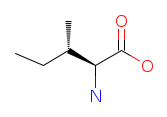Isoleucine
Ehrlich was the first one who discovered Isoleucine in 1904, with its composition being established three years later obtained by a degradation to d-isoamylamine and consequent synthesis through the Strecker reaction with d-isovaleraldehyde.
Chemical Structure of L-Isoleucine

Identifiers and properties of Isoleucine
IUPAC Name: (2S,3S)-2-Amino-3-methylpentanoic acid
Symbol: Three-letter code - Ile. One-letter code - I
Molecular Weight (Molar Mass): 131.17292 g/mol
Molecular Formula (Structural Formula): C6H13NO2
Canonical SMILES: CCC(C)C(C(=O)O)N
Isomeric SMILES: CC[C@H](C)[C@@H](C(=O)O)N
InChIKey Identifier: AGPKZVBTJJNPAG-JOOMIXNWDU
CAS Number: 73-32-5
MDL Number: MFCD00064222
Melting point: 286-288 °C
RNA codons: AUU, AUC, AUA
Solubility in water: 41.2 g/1 L (50 °C); pKa - 2,36; pKb - 9,60
Rf value in n-butanol/acetic acid/water = 12:3:5 - 0.72
2D Molfile: Get the molfile
3D PDB file: Get the PDB file
Other names: (2S,3S)-alpha-Amino-beta-methyl-n-valeric acid; erythro-L-Isoleucine; L-iso-Leucine; (S)-Isoleucine; 2S,3S-Isoleucine
What is the role of Isoleucine?
Basically, Isoleucine is widely recognized as an amino acid able to increase endurance and to help heal muscle tissue. It is particularly recommended to professional athletes and body builders, as the primary function of Isoleucine in the body is to boost up the energy levels and to assist the body in recovering from strenuous physical activity.
Isoleucine is considered as an essential amino acid which is found in lots of proteins. In other words, this amino acid has to be obtained through the diet in adequate quantities in order to meet the needs of your body. Isoleucine is actually an isomer of Leucine and is one of the three branched-chain amino acids that form so-called branched-chain amino acid family. As a matter of fact, the three amino acids (Isoleucine, Leucine, and Valine) constitute nearly 70% of all the amino acids in the body's proteins. That is why their value in human body is so high.
Benefits of Isoleucine
This amino acid may be useful in different aspects. Isoleucine participates in hemoglobin synthesis, as well as in the regulation of blood sugar and energy levels. Studies revealed that this amino acid has a very low toxicity at pharmatological levels up to 8% of solution concentration in rats. Isoleucine also aids in preventing the muscle wasting. This amino acid is known to promote the tissue repair after injury or surgery. Moreover, there is a substantial evidence reported in the literature that branched-chain amino acid family has the anabolic effects on the muscle protein synthesis. That is why a supplementation with Isoleucine may positively influence the increasing muscle protein content in human bodies suffering from the muscle protein loss. A number of authors have presented an evidence indicating that the three amino acids under consideration are vital for stimulating anabolic function in humans. Finally, Isoleucine is converted to blood sugar in the liver, i.e., it can help in maintaining normal blood glucose levels.
Food sources
Isoleucine is one of the essential amino acids and it must be obtained through the diet as the body cannot produce it. Here are some food sources that contain isoleucine along with approximate amounts per serving.
Meat and Poultry. Chicken Breast: A 3-ounce (85-gram) serving of roasted chicken breast provides approximately 0.9 grams of isoleucine. Beef: A 3-ounce (85-gram) serving of cooked beef contains around 1.3 grams of isoleucine.
Fish. Tuna: A 3-ounce (85-gram) serving of cooked tuna provides about 1.2 grams of isoleucine. Salmon: Similar to tuna, salmon contains around 1.2 grams of isoleucine per 3-ounce (85-gram) serving.
Dairy Products. Milk: One cup of milk contains about 0.7 grams of isoleucine. Cheese: Different types of cheese provide varying amounts of isoleucine, typically ranging from 0.5 to 0.8 grams per ounce.
Eggs. One large egg provides approximately 0.5 grams of isoleucine.
Legumes. Soybeans: A 1-cup serving of cooked soybeans contains around 1.6 grams of isoleucine. Lentils: A 1-cup serving of cooked lentils provides about 0.9 grams of isoleucine.
Nuts and Seeds. Almonds: A 1-ounce (28-gram) serving of almonds contains approximately 0.6 grams of isoleucine. Sunflower Seeds: Sunflower seeds provide around 1.4 grams of isoleucine per 1-ounce (28-gram) serving.
Whole Grains. Quinoa: A 1-cup serving of cooked quinoa provides about 0.9 grams of isoleucine. Brown Rice: A 1-cup serving of cooked brown rice contains approximately 0.5 grams of isoleucine.
Dense Protein Sources. Whey Protein: One scoop (around 30 grams) of whey protein powder can provide 2-3 grams of isoleucine.
Seafood. Shrimp: A 3-ounce (85-gram) serving of cooked shrimp provides around 1 gram of isoleucine. Crab: Crab is another seafood source with approximately 1 gram of isoleucine per 3-ounce (85-gram) serving.
Cabbage Family Vegetables. Spinach: A 1-cup serving of cooked spinach contains about 0.4 grams of isoleucine.
These values are approximate and can vary based on factors such as cooking methods, specific varieties of food, and preparation techniques. If you have specific health concerns or conditions that may require additional isoleucine, it's advisable to consult with a healthcare professional or a registered dietitian for personalized advice.